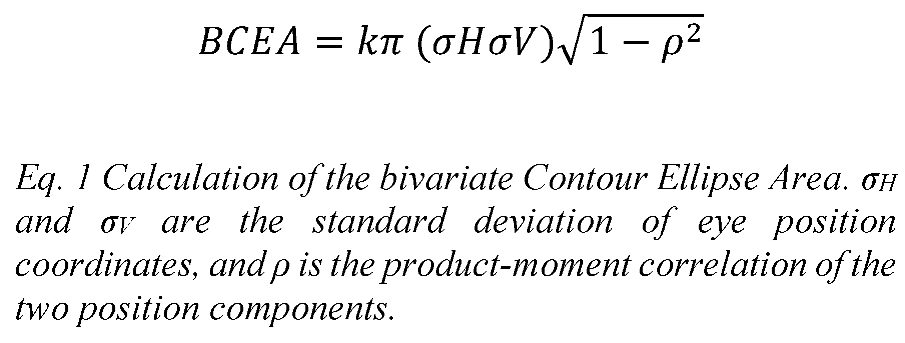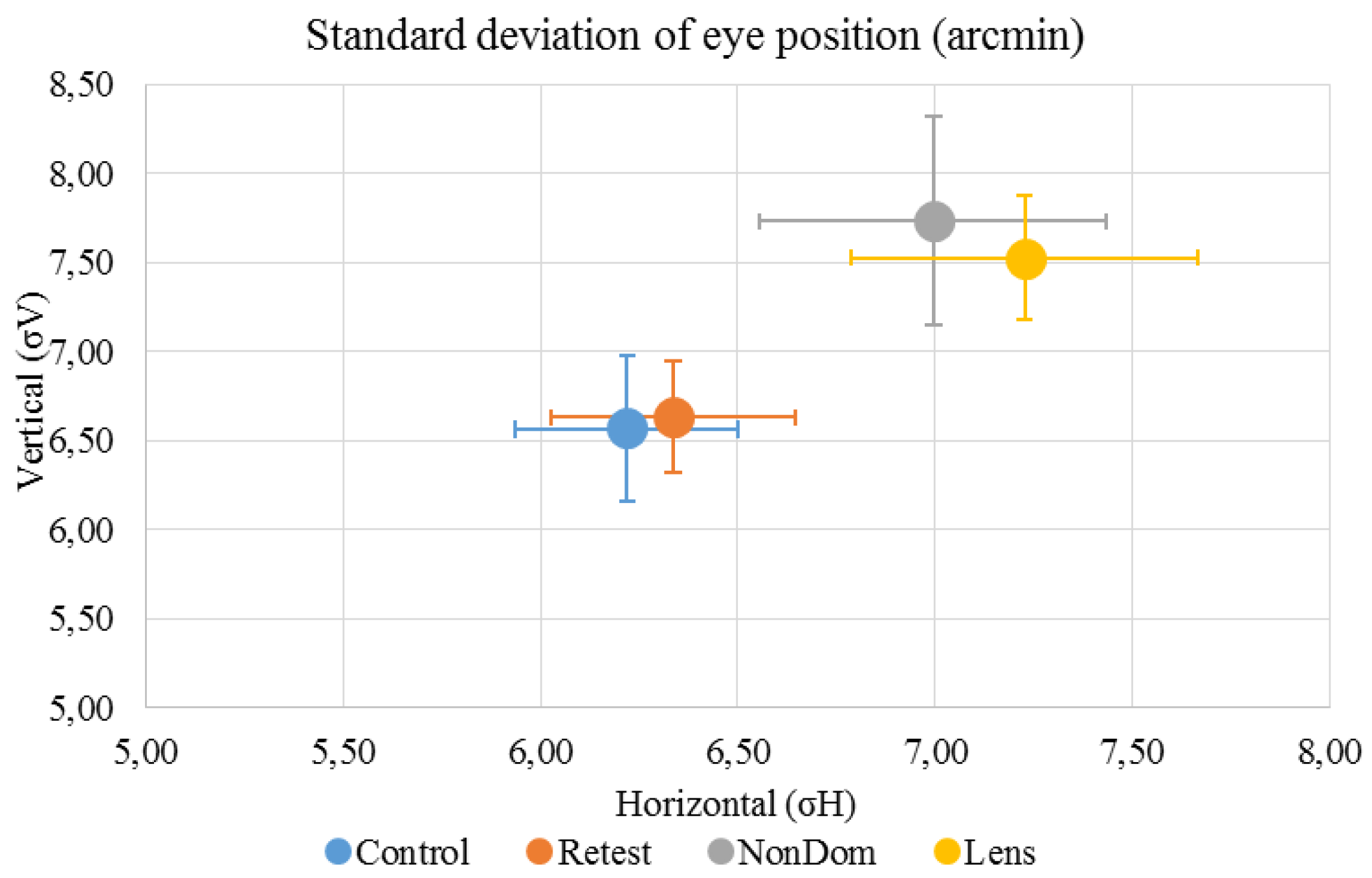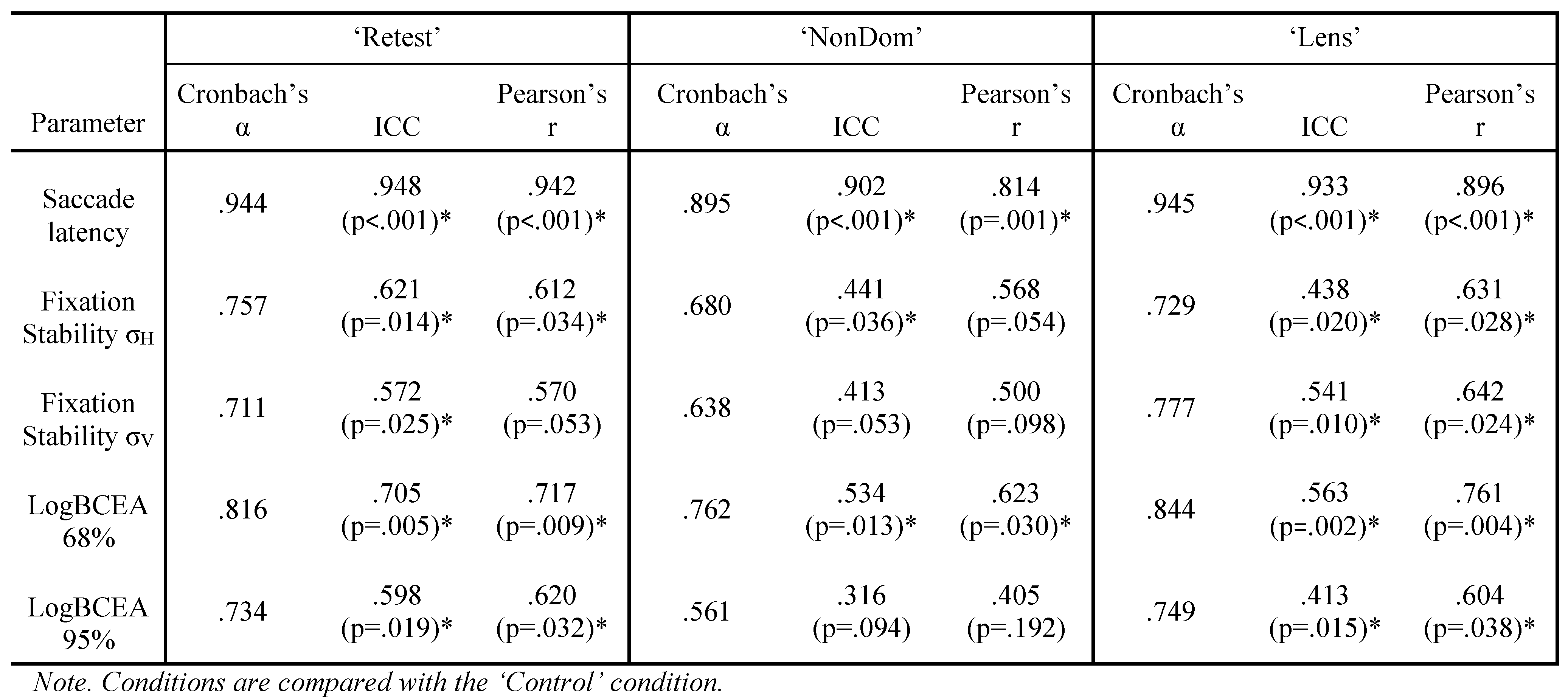Saccade Latency and Fixation Stability: Repeatability and Reliability
Abstract
:Introduction
Reliability and Repeatability
Ocular dominance
Contact lens artefacts
Summary
Materials and methods
Subjects
Procedure
Data Analysis

Statistics
Results
Saccade latency
Fixation Stability
Discussion
Interpreting the results
Saccade latency
Fixation Stability
Conclusion
References
- Amore, F. M., R. Fasciani, V. Silvestri, M. D. Crossland, C. de Waure, F. Cruciani, and et al. 2013. Relationship between fixation stability measured with MP-1 and reading performance. Ophthalmic and Physiological Optics 33, 5: 611–617. [Google Scholar]
- Bartko, J. J. 1991. Measurement and reliability: statistical thinking considerations. Schizophrenia Bulletin 17, 3: 483–489. [Google Scholar]
- Bednarek, D. B., A. Tarnowski, and A. Grabowska. 2006. Latencies of stimulus-driven eye movements are shorter in dyslexic subjects. Brain and Cognition 60, 1: 64–69. [Google Scholar]
- Biscaldi, M., B. Fischer, and F. Aiple. 1994. Saccadic eye movements of dyslexic and normal reading children. Perception 23, 1: 45–64. [Google Scholar]
- Biscaldi, M., B. Fischer, and K. Hartnegg. 2000. Voluntary saccadic control in dyslexia. Perception 29, 5: 509–521. [Google Scholar]
- Biscaldi, M., S. Gezeck, and V. Stuhr. 1998. Poor saccadic control correlates with dyslexia. Neuropsychologia 36, 11: 1189–1202. [Google Scholar]
- Blekher, T., M. R. Weaver, X. Cai, S. Hui, J. Marshall, J. G. Jackson, and et al. 2009. Test-retest reliability of saccadic measures in subjects at risk for Huntington disease. Investigative Ophthalmology & Visual Science 50, 12: 5707–5711. [Google Scholar]
- Blignaut, P., and T. Beelders. 2012. The Precision of Eye-Trackers: A Case for a New Measure. Paper presented at the ETRA 12: Proceedings of the Symposium on Eye Tracking Research and Applications, New York, NY, USA. [Google Scholar]
- Castet, E., and M. Crossland. 2012. Quantifying eye stability during a fixation task: a review of definitions and methods. Seeing Perceiving 25, 5: 449–469. [Google Scholar]
- Cesareo, M., D. Manca, E. Ciuffoletti, V. De Giovanni, F. Ricci, C. Nucci, and et al. 2014. Evaluation of fixation stability using different targets with the MP1 microperimeter. International Ophthalmology. [Google Scholar]
- Chen, F. K., P. J. Patel, W. Xing, M. D. Crossland, C. Bunce, G. S. Rubin, and et al. 2011. Intrasession repeatability of fixation stability assessment with the Nidek MP-1. Optometry and Vision Science 88, 6: 742–750. [Google Scholar]
- Collewijn, H. 2001. Interocular timing differences in the horizontal components of human saccades. Vision Research 41, 25-26: 3413–3423. [Google Scholar]
- Coren, S., and C. Porac. 1982. Monocular asymmetries in visual latency as a function of sighting dominance. American Journal of Optometry and Physiological Optics 59, 12: 987–990. [Google Scholar] [PubMed]
- Crossland, M. D., and G. S. Rubin. 2002. The use of an infrared eyetracker to measure fixation stability. Optometry and Vision Science 79, 11: 735–739. [Google Scholar] [PubMed]
- Ettinger, U., V. Kumari, T. J. Crawford, R. E. Davis, T. Sharma, and P. J. Corr. 2003. Reliability of smooth pursuit, fixation, and saccadic eye movements. Psychophysiology 40, 4: 620–628. [Google Scholar]
- Falkenberg, H. K., G. S. Rubin, and P. J. Bex. 2007. Acuity, crowding, reading and fixation stability. Vision Research 47, 1: 126–135. [Google Scholar] [PubMed]
- Field, A. 2013. Discovering statistics using IBM SPSS statistics, 4th ed. SAGE. [Google Scholar]
- Hendriks, A. W. 1996. Vergence eye movements during fixations in reading. Acta Psychologica 92, 2: 131–151. [Google Scholar]
- Holmqvist, K., M. Nyström, R. Andersson, R. Dewhurst, H. Jarodzka, and J. van de Weijer. 2011. Eye Tracking A Comprehensive Guide to Methods and Measures, 1 ed. New York: Oxford University Press. [Google Scholar]
- ISCAN, I. 2003. Operating Instructions Iscan ETL-300. Ito, M., Shimizu, K., Kawamorita, T., Ishikawa, H., Sunaga, K., & Komatsu, M. (2013). Association between ocular dominance and refractive asymmetry. Journal of Refractive Surgery 29, 10: 716–720. [Google Scholar]
- Johansson, J., G. O. Seimyr, and T. Pansell. 2015. Eye dominance in binocular viewing conditions. Journal of Vision 15, 9: 21. [Google Scholar]
- Klein, C., and P. Berg. 2001. Four-week test-retest stability of individual differences in the saccadic CNV, two saccadic task parameters, and selected neuropsychological tests. Psychophysiology 38, 4: 704–711. [Google Scholar]
- Klein, C., and B. Fischer. 2005. Instrumental and testretest reliability of saccadic measures. Biological Psychology 68, 3: 201–213. [Google Scholar]
- Kloke, W. B., and W. Jaschinski. 2006. Individual differences in the asymmetry of binocular saccades, analysed with mixed-effects models. Biological Psychology 73, 3: 220–226. [Google Scholar] [CrossRef] [PubMed]
- Lopes-Ferreira, D., H. Neves, A. Queiros, M. Faria-Ribeiro, S. C. Peixoto-de-Matos, and J. M. GonzalezMeijome. 2013. Ocular dominance and visual function testing. BioMed Research International 2013 (doi): 238943. [Google Scholar] [CrossRef]
- Mapp, A. P., H. Ono, and R. Barbeito. 2003. What does the dominant eye dominate? A brief and somewhat contentious review. Perception & Psychophysics 65, 2: 310–317. [Google Scholar]
- McDowell, J. E., K. A. Dyckman, B. P. Austin, and B. A. Clementz. 2008. Neurophysiology and neuroanatomy of reflexive and volitional saccades: evidence from studies of humans. Brain and Cognition 68, 3: 255–270. [Google Scholar] [CrossRef]
- Moiseeva, V. V., M. V. Slavutskaya, and V. V. Shul'govskii. 2000. The effects of visual stimulation of the dominant and non-dominant eyes on the latent period of saccades and the latency of the peak of rapid pre-saccade potentials. Neuroscience and Behavioral Physiology 30, 4: 379–382. [Google Scholar] [CrossRef] [PubMed]
- Momeni-Moghaddam, H., C. McAlinden, A. Azimi, M. Sobhani, and E. Skiadaresi. 2014. Comparing accommodative function between the dominant and non-dominant eye. Graefe's Archive for Clinical and Experimental Ophthalmology 252, 3: 509–514. [Google Scholar] [CrossRef] [PubMed]
- Morgan, P. B., N. Efron, M. Helland, M. Itoi, D. Jones, J. J. Nichols, and et al. 2010. Demographics of international contact lens prescribing. Contact Lens & Anterior Eye 33, 1: 27–29. [Google Scholar]
- Niechwiej-Szwedo, E., M. Chandrakumar, H. C. Goltz, and A. M. Wong. 2012. Effects of strabismic amblyopia and strabismus without amblyopia on visuomotor behavior, I: saccadic eye movements. Investigative Ophthalmology & Visual Science 53, 12: 7458–7468. [Google Scholar]
- Niechwiej-Szwedo, E., S. A. Kennedy, L. Colpa, M. Chandrakumar, H. C. Goltz, and A. M. Wong. 2012. Effects of induced monocular blur versus anisometropic amblyopia on saccades, reaching, and eye-hand coordination. Investigative Ophthalmology & Visual Science 53, 8: 4354–4362. [Google Scholar]
- Nystrom, M., R. Andersson, K. Holmqvist, and J. van de Weijer. 2013. The influence of calibration method and eye physiology on eyetracking data quality. Behavioral Research Methods 45, 1: 272–288. [Google Scholar] [CrossRef]
- Peterson, R. C., J. S. Wolffsohn, J. Nick, L. Winterton, and J. Lally. 2006. Clinical performance of daily disposable soft contact lenses using sustained release technology. Contact Lens & Anterior Eye 29, 3: 127–134. [Google Scholar]
- Reingold, E. M. 2014. Eye tracking research and technology: Towards objective measurement of data quality. Visual Cognition 22, 3: 635–652. [Google Scholar]
- Rice, M. L., D. A. Leske, C. E. Smestad, and J. M. Holmes. 2008. Results of ocular dominance testing depend on assessment method. Journal of American Association for Pediatric Ophthalmology and Strabismus 12, 4: 365–369. [Google Scholar] [PubMed]
- Rommelse, N. N., S. Van der Stigchel, and J. A. Sergeant. 2008. A review on eye movement studies in childhood and adolescent psychiatry. Brain and Cognition 68, 3: 391–414. [Google Scholar] [PubMed]
- Scheiman, M., and B. Wick. 2002. Clinical Management of Binocular Vision: Heterophoric, Accommodative, and Eye Movement Disorders, 2nd ed. Philadelphia ed.): Lippincott Williams & Wilkins. [Google Scholar]
- Smyrnis, N. 2008. Metric issues in the study of eye movements in psychiatry. Brain and Cognition 68, 3: 341–358. [Google Scholar] [CrossRef]
- Stein, J. F., A. J. Richardson, and M. S. Fowler. 2000. Monocular occlusion can improve binocular control and reading in dyslexics. Brain 123, Pt 1: 164–170. [Google Scholar]
- Stein, J. F., P. M. Riddell, and M. S. Fowler. 1987. Fine binocular control in dyslexic children. Eye 1(Pt 3), 433–438. [Google Scholar]
- Stein, J. F., P. M. Riddell, and S. Fowler. 1988. Disordered vergence control in dyslexic children. British Journal of Ophthalmology 72, 3: 162–166. [Google Scholar]
- Steinman, R. M. 1965. Effect of Target size, Luminance and Color on Monocular Fixation. Journal of the Optical Society of America 55, 9: 1158–1165. [Google Scholar] [CrossRef]
- Ukwade, M. T., and H. E. Bedell. 1993. Stability of oculomotor fixation as a function of target contrast and blur. Optometry and Vision Science 70, 2: 123–126. [Google Scholar]
- van der Geest, J. N., and M. A. Frens. 2002. Recording eye movements with video-oculography and scleral search coils: a direct comparison of two methods. Journal of Neuroscience Methods 114, 2: 185–195. [Google Scholar] [PubMed]
- Wade, N. J., and B. W. Tatler. 2011. Origins and applications of eye movement research. Edited by S. P. Liversedge, I. D. Gilchrist and S. Everling. In The Oxford Handbook of Eye Movements. Oxford: Oxford University Press, Vol. 1, pp. 17–45. [Google Scholar]
- Wilson, S. J., P. Glue, D. Ball, and D. J. Nutt. 1993. Saccadic eye movement parameters in normal subjects. Electroencephalography and Clinical Neurophysiology 86, 1: 69–74. [Google Scholar] [PubMed]
- WMA. 2013. WMA Declaration of Helsinki Ethical Principles for Medical Research Involving Human Subjects. http://www.wma.net/en/30publications/10policie. World Medical Association. [Google Scholar]
- Wöstmann, N. M., D. S. Aichert, A. Costa, K. Rubia, H. J. Moller, and U. Ettinger. 2013. Reliability and plasticity of response inhibition and interference control. Brain and Cognition 81, 1: 82–94. [Google Scholar]
- Yang, Q., and Z. Kapoula. 2003. Binocular coordination of saccades at far and at near in children and in adults. Journal of Vision 3, 8: 554–561. [Google Scholar] [PubMed]
- Zeri, F., M. De Luca, D. Spinelli, and P. Zoccolotti. 2011. Ocular dominance stability and reading skill: a controversial relationship. Optometry and Vision Science 88, 11: 1353–1362. [Google Scholar]
- Zhang, Y., J. Laurikkala, and M. Juhola. 2014. Biometric verification of a subject with eye movements, with special reference to temporal variability in saccades between a subject's measurements. International Journal of Biometrics 6, 1: 75–94. [Google Scholar]



 |
Copyright © 2016. This article is licensed under a Creative Commons Attribution 4.0 International License.
Share and Cite
Vikesdal, G.H.; Langaas, T. Saccade Latency and Fixation Stability: Repeatability and Reliability. J. Eye Mov. Res. 2016, 9, 1-13. https://doi.org/10.16910/jemr.9.2.3
Vikesdal GH, Langaas T. Saccade Latency and Fixation Stability: Repeatability and Reliability. Journal of Eye Movement Research. 2016; 9(2):1-13. https://doi.org/10.16910/jemr.9.2.3
Chicago/Turabian StyleVikesdal, Gro Horgen, and Trine Langaas. 2016. "Saccade Latency and Fixation Stability: Repeatability and Reliability" Journal of Eye Movement Research 9, no. 2: 1-13. https://doi.org/10.16910/jemr.9.2.3
APA StyleVikesdal, G. H., & Langaas, T. (2016). Saccade Latency and Fixation Stability: Repeatability and Reliability. Journal of Eye Movement Research, 9(2), 1-13. https://doi.org/10.16910/jemr.9.2.3



